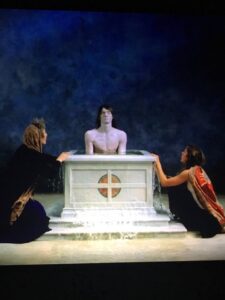
Liviana Martin

Exciting, engaging, a journey inside oneself: for Bill Viola’s exhibition, which began in Milan and will end on June 25th, these descriptions are nothing compared to the sensations that the artist’s videos made me feel. Imagine dark, muffled rooms, where the only lights come from figures in very slow movement, now far away, now very close, with bright colors or in a milky black and white. Each video speaks to us: depending on our experiences, we think we see our anxieties, joys, hopes, profound themes such as reflection on life and death.
Bill Viola was born in New York in 1951. Pioneer of video art, in over forty years of career, he has explored the possibilities of video, creating a powerful aesthetic language, influenced by his stay in Florence in 1974, as technical director of the experimental center art/ tapes/22 , and by his travels in the East, especially in Japan. The contrasts between Western and Eastern culture harmonize in his work, they complement each other. Viola says that his art is neither cinema nor painting, but an expansion of the levels of reality. His installations are extraordinary experiences of immersion in space, image and sound. Time is dilated, slowed down, stopped; the movements become very slow, until the irruption of something unexpected that takes us by surprise, as happens in life.
Water is one of the recurring motifs in his work. The artist says that as a child he almost drowned, but cites that episode as one of the best memories of his life. He sat “Buddha-like” on the bottom of the lake and was mesmerized by the beauty of the underwater world. Many of his videos reproduce the motif of water, which pours, submerges, flows, a vital or mortal element.
In the video The Raft (2004), a group of people of different ethnic origins and social backgrounds are suddenly hit by a powerful jet of water: the water overwhelms everything, the bodies are thrown to the ground, their faces are devastated from anguish in front of an inexplicable force. Suddenly, the water stops, leaving behind a group of disoriented and aching individuals, but aware of their need to collaborate in order to survive unexpected catastrophes.
In Tristan’s Ascension the body of a dead man is shown in glaring black and white, lying on a block of gray stone. For a long time nothing happens: suddenly, a waterfall pours down on him ever more violently, until the man ascends towards the heavens in a sort of transfiguration, of ascent of the soul into space after death.
During his stays in Tuscany in the 1970s, Viola breathed the Renaissance everywhere: in the churches, in the squares, in the architecture of the palaces. One of his most beautiful works, The Greeting (1995), is inspired by the Visitation, a painting by Pontormo, a Tuscan painter from the 1500s. The video, lasting 10 min. 22 sec. in slow motion, shows the meeting of two women, one young and one old, to which a third will be added later. Pontormo’s painting refers to an episode of the Gospel which tells of the meeting between Mary, pregnant with Jesus, and Saint Elizabeth, pregnant with John the Baptist. At the beginning of the video, the two women embrace, talk and practically nothing happens. When a third woman appears out of nowhere (perhaps an angel who has come to protect them), the whole situation changes. The slowing down of the movements creates a before and after with respect to the narrated scene. Every slightest variation and blowing of the wind are examined in the smallest details: the colored dresses that move, the tender gestures of the embrace, the changing of the expressions that bring to light also the unconscious aspects of the characters.

The video projection Emergence (2002), lasting 11 min. 40sec, refers to the fresco Cristo in pietà (1424) by the Tuscan painter Masolino da Panicale (which depicts Christ rising from the tomb, supported by the Madonna and St. John). Two women watch sitting on either side of a marble well, marked by a cross. Slowly, the very pale body of a young man emerges from the well-sepulchre: first the head appears, then with great effort the body, causing the water to overflow from the well. The two women hold him up and place him on the ground, covering him with a cloth.
The water that flows from the sepulcher is a reference to both the beginning (the amniotic fluid) and the end of life. Christian thought and Eastern spirituality come together in an original syncretism.
As Domenico Piraina, director of Palazzo Reale writes,
“Bill Viola’s works invite us to savor life, to reflect on what is truly essential, indispensable, primary, to focus on ourselves, on our thoughts, on our feelings, on our emotions.“
Bill Viola, Palazzo Reale, Milan
February 25 – June 25, 2023
Tickets – 15 euro

